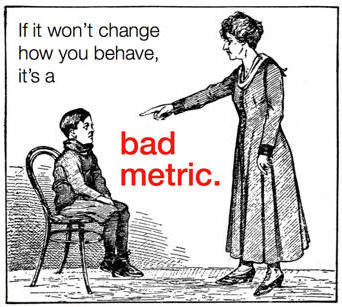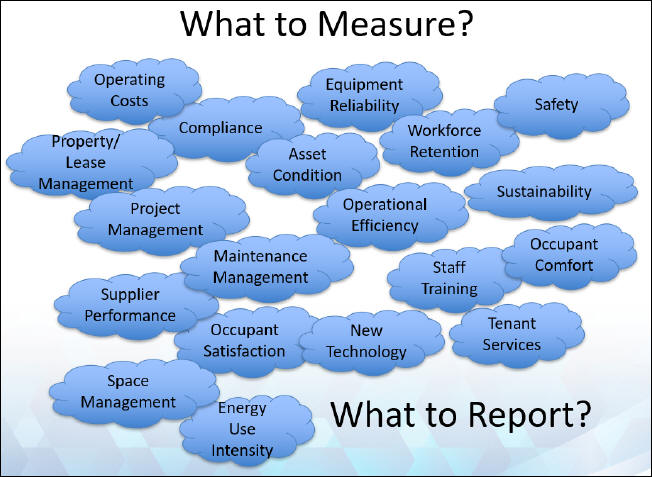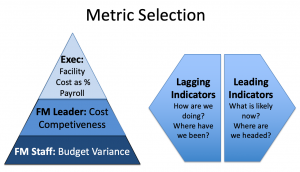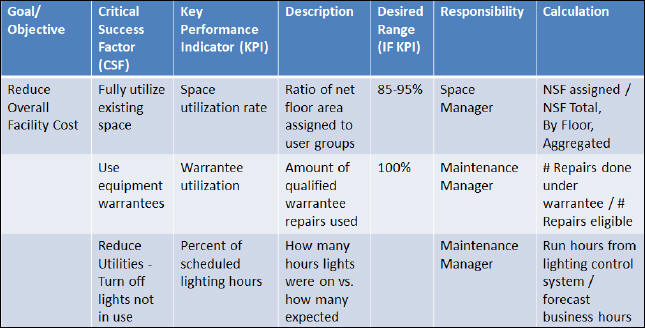The only facility management metrics that matter are those you use. So how to come up with useful ones and avoid just accumulating a lot of statistics?
Start with the questions you want to answer – the facility management metrics that answer these questions are the ones that matter to you:
- Do we have the right (type, amount, location) space to accomplish the organization’s mission?
- Are we paying competitive rates to have and maintain this space?
- Which areas are not performing as well as expected or not meeting the desired service level?
- Where are we likely to need investment in this building during the next five years?

The absolute value of a metric is not as important as its range or trend and using it with judgement.
Avoiding bad facility management metrics is far better than having perfect metrics.
The Difference Between Facility Metrics and Key Performance Indicators (KPIs)
It is important to distinguish between measures, metrics, and KPIs in your planning, so let’s define these for discussion (you can use other terminology in your organization, but the concepts of these different types are important).
Measures (measurements) are the (scalar) data about your facilities and operations. Examples are: gross square feet (GSF), total cost of maintenance activities, number of facility occupants, run-hours, temperature of a motor, etc.
The number of measures is only limited by the type and quantity of data that is available to you. We need to keep in mind that measurement is just quantifying an existing state to reduce uncertainty about it – the measurement should have an accuracy and precision suitable for its purpose. The use of a measure is to determine the raw quantity of something (to identify total area or if equipment is within a proper operating range).
Facility management metrics are a combination of two or more measures, typically with a denominator to “normalize” the data for comparison. Examples are: GSF per person, Annual Maintenance Cost per GSF, run-hours per oil change, etc.
A relatively large number of facility metrics about the various dimensions of your facility portfolio and facility operations are handy to draw upon when needed. Facility Management Metrics are the foundation of facility management because many are performance indicators that reflect a performance measure per unit.
Lagging metrics are useful to tell how well our organization/facility performed while leading metrics are useful to forecast the likely trend (or to set goals for performance). Metrics are also used for facility benchmarking because they can be compared between different facilities and organizations.
KPIs (or key performance indicators) are selected metrics that answer a key facility management question.
For example, “GSF per person” can be a KPI for the question of “Do we have the right amount of office space?”
A limited number of KPIs are suggested for each role in the facility organization in order to allow management focus (everything cannot be equally important).

Multiple Dimensions of Facilities Yield Many Facility Management Metrics
Facilities are complicated, with multiple “dimensions,” each of which has different measures and metrics. Because it takes time and effort to collect and report data, we need to understand facility metrics that matter to us, so we know what to measure and what to report.
Here are some common facility metrics to consider as a start (see a list of other example metrics):
- GSF/Person (for office space)
- Maintenance Cost/GSF
- Custodial Cost/cleaned SF
- Utility Cost/GSF
- Percent of PMs Completed on Time
- Percent Planned WO
- Asset Condition (FCI)
- Customer Satisfaction (% Satisfied)
- Safety – Reportable Incidents, Lost Time (FM staff)
- Safety – Accidents (building occupants/visitors)
- Energy Use Intensity (EUI)
- Water Use Intensity
- Total facility cost per business activity unit
- Percent facility availability when needed

Metrics are specific to the user’s role. Even metrics within the same dimension (space, cost) are likely to be framed differently based upon how the information is used or impacted by the user.
An example of metrics by role:
- Facility Director – Scheduled Maintenance within Designated SLA
- Facility Manager – % Work Orders Completed on Time by Trade/Building
- Building Engineer – # Assigned Work Orders Due this Week
Draft your list by role – this exercise will not just help you build your list of metrics, but will also help you identify where you have misalignment in the organization:
How to Build Your Own List of Facility Management Metrics that Matter
- Start with the Key Performance Questions (KPQ) at the top level of your organization and the Key Performance Indicators (KPI) that answer those questions.
- Then have each functional area identify the associated KPQ and KPI within their area of operations. Continue down to the lowest level function. (Or each function can build their own list independently and then you can combine the lists.) Consider both metrics that show how you have done (lagging) and ones that suggest how you are trending (leading).
- Once you have a list of KPQ and KPI, identify the associated metrics or measures you will need and define how you will measure and calculate them. (Use industry standard calculations wherever possible.) You can add the data source, any critical success factors, and frequency of measurement.

When you build a list like this, it will become apparent which of your facility systems will be the key source for each measure, and how much effort it may take to assemble your metrics, so you can start to prioritize which will be measured and reported based upon the estimated value or importance of each.
Employ facility management metrics that matter to your organization. There are potentially hundreds of metrics associated with the various dimensions of facilities: space, cost, quality, environment, operations, projects, etc. Start with the facility metrics that answer your key performance questions to address your priorities, and then add others of interest as your resources allow.
Facility Metrics & Scorecards
Facility Issues can help you identity metrics of value and setup your custom facility scorecard that does not need new software or a dedicated analyst.
